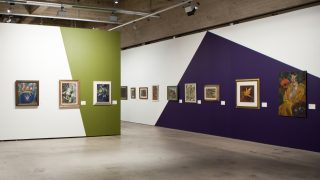Espoo Museum of Modern Art


02.03.2012 - 10.06.2012
Italian Futurism 1909-1944
Futurism was an important art movement in Italy in the first half of the 20th century. Focussing on the new urban world and concept of man, it scorned all that was old and traditional, and glorified machines, technology, speed, noise and movement.
“We declare that the splendour of the world has been enriched by a new beauty: the beauty of speed. A racing car with its bonnet adorned with great tubes like serpents with explosive breath … a roaring motor car which seems to run on machine-gun fire, is more beautiful than the Winged Victory of Samothrace.”
The fourth thesis of the manifesto published by the Italian poet and editor Filippo Tommaso Marinetti (1876-1944) in La gazzetta dell’Emilia on 5.2.1909, later reproduced in the French daily Le Figaro, crystallises the whole philosophy of Futurism: a noisy racing car versus the classical marble statue.
In addition to issuing manifestos, the Futurists organised mass meetings, provocative and absurd performances, which frequently ended in riots.
Futurism, one of the lesser known ‘isms’ of the arts, thrived particularly well in Italy into the 1940s. It was expected to lead to an international revolutionary movement that would influence social thinking in addition to the arts. Its influence was most clearly seen in Russian, Germany and Great Britain, but in Finland, for example, it found no echo.
With its impact on literature, music, the visual arts, cinema, design and theatre, Futurism was part of the general political, industrial and cultural turbulence in Europe at the time. In Italy it acquired powerful nationalist overtones. The Futurists denied the past and aimed at creating an entirely new culture.
The Futurists were attracted to everything that symbolised modern life: noise, hubbub, machines, gadgets, speed, movement and violence. They welcomed the outbreak of the First World War as a chance to destroy the old, but soon the sheer brutality of it caused many of them to change their attitude.
The new exhibition at EMMA continues the museum’s series on the phenomena of Modernism. The fascination with machines and speed, like Futurism in general, is very masculine, so out of the 52 artists represented, only three are women. Covering the whole lifecycle of Futurism, the exhibition displays paintings, sculptures, sketches, architectural designs, objets and furniture. Futurism never differentiated between abstract and representational art, what was important in these powerful colourful works was movement. The most popular motifs were machines, cars and aeroplanes, but they were also populated by people and animals.
Artists:
Enrico Allemandi 1910–1984
Cesare Andreoni 1903–1961
R.M. Baldessari 1894–1965
Giacomo Balla 1871–1958
Barbara 1915–2002
Vasco Battistoni 1895–1962
Benedetta 1897–1977
Umberto Boccioni 1882–1916
Arturo Bragaglia 1893–1962
Attilio Calzavara 1901–1952
Francesco Cangiullo 1884–1977
Pasqualino Cangiullo1900–1975
Carlo Dalmazzo Carrà 1881–1966
Arturo Ciacelli 1883–1966
Umberto Primo Conti 1900–1988
Tullio Crali 1910–2000
Francesco Cristofanetti 1901–1951
Fortunato Depero 1892–1960
De Pistoris 1898–1975
Di Bosso1905–1982
Nicolay Diulgheroff 1901–1982
Gerardo Dottori 1884–1977
Leonardo Dudreville 1885–1975
Carlo Erba 1884–1917
Julius Evola 1898–1974
Farfa 1881–1964
Fillia 1904–1936
Achille Funi 1890–1972
Gino Galli 1893–1954
Arnaldo Ginna 1890–1982
Virgilio Marchi 1895–1960
Filippo Tommaso Marinetti 1876–1944
Mario Nannini 1895–1918
Emilio Notte 1891–1982
Pippo Oriani 1909–1972
Vinicio Paladini 1902–1971
Ivo Pannaggi 1901–1981
Enrico Prampolini 1894–1956
Pippo Rizzo 1897–1964
Angelo Rognoni 1896–1957
Romolo Romani 1884–1916
Ottone Rosai 1895–1957
Mino Rosso 1904–1963
Luigi Russolo 1885–1947
Gino Severini 1883–1966
Sibò 1907–2000
Mario Sironi 1885–1961
Ardengo Soffici 1879–1964
Tato 1896–1974
Thayaht 1893–1959
Lucio Venna 1897–1974
Rougena Zatkova 1885–1923
In cooperation with
Futur-ism
Galleria Comunale d’Arte Moderna of Roma
Estorick Collection of Modern Italian Art of London
Unicredit Group Collection
Curators:
Giancarlo Carpi
Marco Ancora